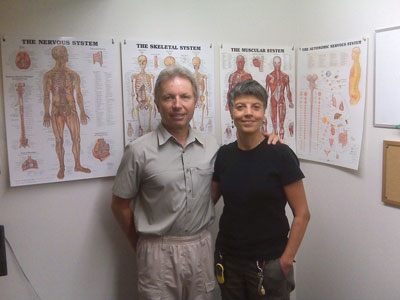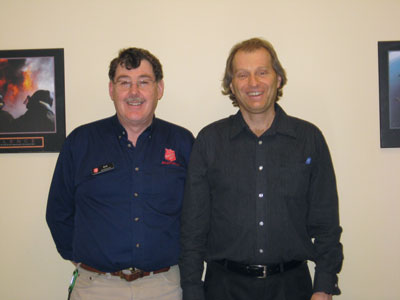
For the chiropractic profession, community outreach, like all efforts by its practitioners, has many branches. Some chiropractic groups raise funds for local charities and/or health-care facilities and hospitals.
For the chiropractic profession, community outreach, like all efforts by its practitioners, has many branches. Some chiropractic groups raise funds for local charities and/or health-care facilities and hospitals.

|
| Dr. Lawson, volunteer chiropractor at the Yonge Street Mission, with YSM assistant director and multidisciplinary clinic creator and developer, Ruth Ewert, RN. Advertisement
|
Some perform spinal evaluations at community events or local malls. Certain DCs will participate in amateur sports, as chiropractor to the team. Some teaching clinics provide chiropractic in areas where it might not otherwise be accessible to the local income demographic. Other doctors will conduct open-to-the-public health and wellness classes or visit local schools. All of these options serve to heighten public awareness of chiropractic and make DCs available to people who would not otherwise have considered it an option, or who could not have afforded to visit one even if they had wanted to. But there still remains a portion of society with absolutely no access to chiropractic care, no matter how great the need for it – these are the destitute who are homeless and/or in such poverty that the road to accessing treatments by a specialist is not even on their map for daily survival.
This is the story of two chiropractors whose own personal vision of community outreach involves making their services available to this group of people through working with mission organizations in their communities.

|
|
| Dr. Larry Smith (right) with Maj. Rob Anderson of the Salvation Army Mission. |
Dr. Lawson and The Yonge Street Mission
Located in Toronto’s downtown core on, as its name suggests, Yonge Street, the Yonge Street Mission (YSM) has been providing a safe haven for youth, ages 16-24 – and, when applicable, their children – since 1993. It is unassumingly stuffed between a colourful mixture of inner city businesses, in an area where the commerce ranges from family food establishments to adult entertainment lounges. The floors above many of these are used as residential spaces – one can see an array of creative window dressings from the bustle of the street below. The distractions that surround it can make the YSM almost unnoticeable – but it does not go unrecognized amongst those whose lives it has impacted. Those who come to the mission include runaways, kids who are abused or struggling with addictions, and homeless young parents, to name a few. They hail from a wide range of backgrounds; some are, ironically, from very privileged homes – where support for their problems has not been forthcoming – and others from environments of debilitating poverty. The mission offers protection within a surprisingly friendly-looking drop-in environment. Activities are made available daily, as well as food, counselling of various sorts, a nursery, and, in what one might call the bowels of the building, a career centre and a heath clinic. Youths in need are never discriminated against, regardless of social standing, race, creed, sexual orientation, nature or severity of illnesses, or any other characteristic. All who need help are welcome.
While providing assistance with basic needs, YSM also strives to teach youths valuable life skills, such as training them to keep a house and/or retain a job. Skills and concepts are introduced one step at a time, in an attempt to slowly build each individual’s sense of dignity, self-esteem and worth, and foster a constructive, sustainable independence. Mission staff work daily to reach out through a variety of programs that are carefully targeted to each individual’s unique needs.
The health-care facility at the YSM offers a holistically structured blend of services. The vision of, and almost single-handedly developed by, a registered nurse named Ruth Ewert, the clinic is composed of over 60 health professionals, including family doctors, dentists, psychologists, nurses, RMTs, a naturopath, foot specialists and chiropractors, all of whom participate on a volunteer basis. The clinic also benefits from established relationships with local pharmacists and receives a number of donations from various medical and health-care suppliers. Ewert aspires to attract good people to staff the clinic, constantly searching for experienced practitioners with a solidly patient-centred philosophy.
“Eighty-five per cent of our kids are abused,” says Ewert, whose aura of constructive realism and inclusive compassion is devoid of worldly pessimism or unnecessary pathos. “They require an adult they can trust, and trust takes time and effort to build.”
A different brand of experience
It was part of Ewert’s personal vision to include chiropractic services in the YSM clinic. As a result, a growing cohort of DCs are becoming involved, including Dr. Gordon Lawson, a Toronto chiropractor with a wide range of clinical experience.
After four years as one of YSM’s regular volunteer DCs, Dr. Lawson aspires to provide benefits that extend beyond musculoskeletal issues to include nutritional counselling. He spends as much time as necessary with each patient, in an effort to open a dialogue, thus accessing “the whole person” sitting in front of him, and building that individual’s ability to trust.
“I spend at least half an hour getting to know them and making sure they understand that my interaction with them is completely non-judgmental,” says Dr. Lawson. “Their symptom serves as a portal of entry – it is not an end, in itself.”
“Chiropractic offers the kids a solution that is drug-free,” he continues. “Many of these kids have faced addictions and the last thing they need, or, very often, want, is to be given drugs.”
Dr. Lawson describes working with youth at the YSM as a very different and eye-opening experience.
“A young man once came to me for pain in his feet – it turns out he had trench foot” is the example he recounts. “Trench Foot – originally named so because it was widely noted in soldiers of the First World War who stood in cold, dank trenches wearing the same pair of, often, dilapidated socks and boots – is an infection of the feet that can result in gangrene and amputation if it is not treated. It turns out that it is quite common amongst people who live on the streets – and it is not pathology that a chiropractor would typically see in clinic.”
Though clinically interesting, this incident resulted in more than a lesson in pathology for Dr. Lawson.
“The young man removed his boots and I proceeded to examine his feet and talk about how we were going to deal with them,” he recalls. “Well, he was appalled that anyone would want to touch his feet – he was also very moved that, rather than being repulsed and backing off, someone would actually reach out and lay their hands on his very compromised flesh.
“It occurred to me, then, that touching one’s feet is a funny thing – it is humbling for the one touching and the one being touched. Therefore, it becomes about more than just healing the physical symptom. It’s about touching the person where they are at, at that time, and building a bridge to other, deeper issues.
“The issue of touch anywhere is also a sensitive one when dealing with kids who have been abused, sexually and otherwise. Chiropractic becomes ‘good touch’ for these kids – a healing touch that can be very therapeutic but that also lets them know it is possible to touch someone in a positive way.”
Dr. Lawson very happily continues to give his time to the YSM, and encourages other chiropractors to consider helping out in this manner, in their own communities, if their schedules and circumstances allow for it.
“It is a chance to give back,” he notes, “but it’s also a chance to learn so much more than you ever would in your office – to learn about clinical matters but also to learn about the world in a very different way.”
Dr. Larry Smith and the Salvation Army Mission
Whereas Dr. Lawson joined an already existing multidisciplinary health-care team at an inner-city mission, Dr. Larry Smith, a chiropractor and Iron Man triathlete from Parksville, British Columbia, has made chiropractic available to those who cannot otherwise afford it through a mission in a less urban area.
“It was a month before Christmas and I was enthusiastically planning my holidays when I asked myself a very timely question,” says Dr. Smith.“What can I do to help the people in my community? At that very same moment, I received a serendipitous e-mail from fellow chiropractors Dr. Norm Detillieux and Dr. Helen Bergstrom in Nanaimo. They were ‘looking for a kind-hearted, generous, skilful chiropractor to adjust those in need, through the Salvation Army, on a volunteer basis during the holiday season.’
“I was certainly eager about the idea, and my girlfriend pointed out that it would be the best Christmas gift of all for some of those people! That was it! I decided that volunteering would be a present for both me and those in need! After experiencing two successful and enjoyable sessions in Nanaimo, I was asked by Maj. Rob Anderson if I would be interested in setting up a volunteer mission in my home town of Parksville. After a few meetings with local Major Rolf Guenther, the project began on April 7, 2010.”
The beauty is in the simplicity
“I am set up in the nursery of the Salvation Army Church,” continues Dr. Smith. “There is a sign posted outside the ‘soup kitchen’ advertising that chiropractic care is available. The program is open to anybody in our community who wants to receive chiropractic care but cannot afford to pay for it. Initially the registration and reception work was provided by patients who volunteered from my office. They have graciously handed this responsibility over to the clients of the Salvation Army soup kitchen.
“The beauty of this mission is in its simplicity. Armed with my portable chiropractic table, portable file box and an enthusiastic receptionist, I treat people during the lunch hour every Wednesday between noon and 1:30. Naturally, complete patient records are kept, but there are no qualms about billing, payment or insurance companies! There is always an enthusiastic buzz in the reception area and a deep sense of caring and concern between the patients. Without exception, there is a very real sense of gratitude from all those who receive chiropractic care. That is why I leave each session with more energy than I arrive with.”
Dr. Smith states that the goal of Drs. Detillieux and Bergstrom was to inspire other professionals to help those in the community who need it most. Speaking from his own experience, now, he wants to pass this message along and encourage chiropractors to reach out into their own communities to provide the amazing gift of chiropractic care to those who need it the most.
It is always wonderful to hear a chiropractic success story. You know the one: where a patient suffers from pain or illness that affects the full spectrum of their lives – or even threatens their existence – and then is cured, or at least vastly improved, through receiving care from a chiropractor. How much more inspiring the story becomes when a DC goes out into the community to provide chiropractic, especially to those who, arguably, are in the greatest need of being cared for. Ah – the story has become more than wonderful or inspiring. It is now a love story. But, the hero is neither the doctor, nor the patient who turned to chiropractic. If one examines the love stories told by Drs. Lawson and Smith, one learns that the hero is the energy that pulls people in need together with those who can help, benefiting both of them and carving indelible lessons on the lives of all who are involved.
Print this page